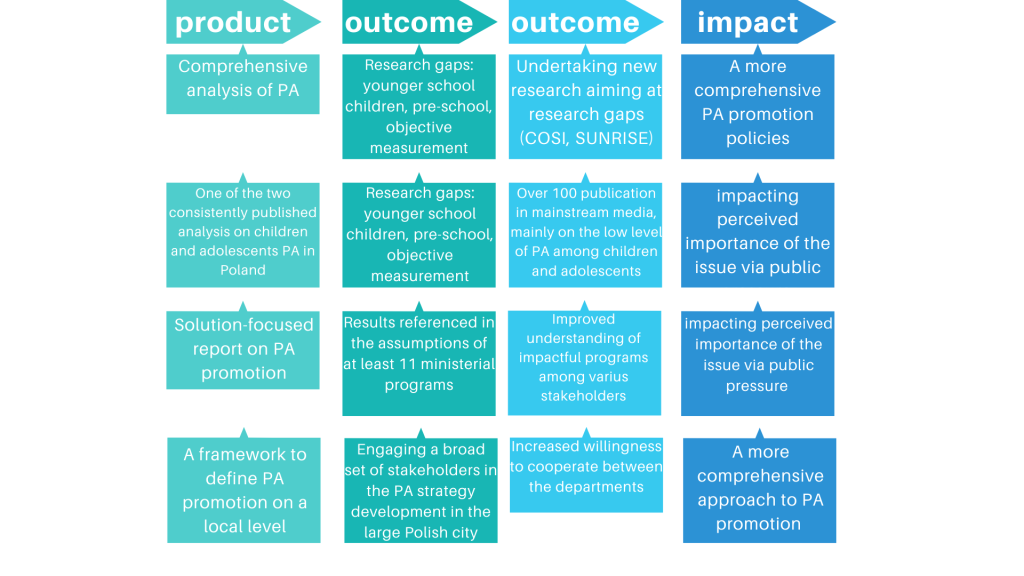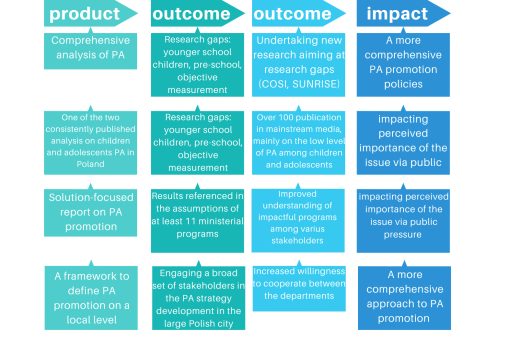On Monday, I had the opportunity to discuss the national influence of the Global Matrix project on physical activity (PA) promotion policies in Poland. The event organised by the Ministry of Sport and Tourism was a part of the Polish presidency of the Council of the European Union. The conference, titled ‘Research as the foundation of sports policy – challenges and perspectives’, was organized at the National Stadium for EU stakeholders.
I feel proud to be enabled to discuss this bottom-up project’s impact in front of an expert audience in the context of the Polish presidency. The Global Matrix is an international effort to standardize and benchmark physical activity (PA) levels. In Poland what began as an academic exercise has evolved into a significant tool for advocacy, policy formulation, and even public pressure. While it would be naive to suggest that it has revolutionized physical activity policy implementation in Poland, I believe that work that has been done in GM has already been shaping the national discourse on PA.
A Global Scorecard with Local Ramifications
The Active Healthy Kids Global Alliance (AHKGA) launched the Global Matrix initiative in 2014, offering a comparative assessment of children’s PA worldwide. Global Matrix is a summary of the work that has been done on a national level, in which national teams produce Report Cards. The Report Card assigns letter grades to different indicators describing PA-related behaviours, personal characteristics and sources of influence, based on the synthesis of the best available data. Each indicator has common benchmarks. The Report Card development process follows uniformed steps and the grades are evaluated by external teams to ensure comparativeness.
Poland joined the initiative in 2016 and since then has participated in three editions. Its impact in Poland has grown steadily, transforming from a niche research effort into a widely referenced policy instrument.
Outcomes
With over 100 publications and mainstream media coverage, the Global Matrix has become one of the most cited sources on physical activity among Polish children and youth. It has illuminated stark realities—low physical activity levels, inadequate public sector engagement, and a fragmented policy landscape. In doing so, it has forced policymakers to take notice.
Influencing Policy Through Data
The influence of the Global Matrix on Poland’s PA policies is best understood through the public policy cycle. At the problem identification stage, it has provided rigorous comparative analysis, revealing research gaps and guiding subsequent inquiries. Representative data on PA levels had previously been limited to adolescents aged 11 to 15, neglecting younger children, those with disabilities, and some important dimensions of physical activity behaviours such as role of active play. The Global Matrix’s findings inspired new research projects such as the SUNRISE (led by Hanna Nałęcz) and COSI studies, which have expanded the scope of PA surveillance in preschoolers and younger children.
At the agenda-setting phase, the Global Matrix has been instrumental in shaping public discourse. In the absence of consistent governmental PA surveillance, it remains one of only two regularly published analyses on Polish children’s physical activity (HBSC remains the main source of information). The media exposure has elevated the issue’s perceived importance, applying public pressure on authorities to act.
The most tangible impact has been observed at the policy formulation stage. The findings of the Global Matrix have been referenced in at least 11 ministerial programs, including initiatives like ‘Active Return to School’ and ‘School Sports Club.’ Furthermore, we had an opportunity to use the Global Matrix framework while developing PA and sport strategy in one of the largest cities in Poland, demonstrating its ability to facilitate interdepartamental dialogue on PA promotion.
Private sector actors have also taken note. Poland’s largest sports sponsors, such as Orlen, now cite the Global Matrix in their corporate social responsibility (CSR) initiatives. Although these CSR programs rarely prioritize impact, their reference to the Global Matrix suggests a growing awareness within sponsorship departments.

Challenges in Implementation and Evaluation
Despite its success in influencing agenda-setting and policy formulation, the Global Matrix has had little impact on policy implementation in Poland. The country’s top-down, bureaucratic approach to sports governance has left little room for innovative initiatives. Interministerial cooperation remains limited (although the situation seems to improve in the last years), and comprehensive PA promotion strategies have yet to materialize.
Nevertheless, the initiative has strengthened policy evaluation mechanisms. By introducing standardized indicators, it has increased transparency and provided stakeholders with tools to scrutinize government efforts. In a system where accountability has historically been weak, this represents a modest yet significant shift.
A Model for Future Progress
The Global Matrix’s role in Poland shows opportunities for the bottom-up, research-led initiatives in shaping public policy. It has provided an empirical foundation for decision-making, spurred new research, and fostered public discourse. More importantly, it has demonstrated that data-driven advocacy can influence a traditionally rigid policy environment.
For Poland to fully leverage the Global Matrix’s potential, policymakers must integrate its findings into a coherent, long-term strategy for PA promotion. This requires breaking down bureaucratic silos, enhancing cross-ministerial collaboration, and committing to evidence-based policymaking. Until then, the Global Matrix will remain a powerful diagnostic tool—one that highlights challenges but awaits meaningful action.
